Nov 20, 2009
Alumni Letters Coming to Penn State Calling for Investigation of Michael Mann
One such example below is from PSU meteorology grad Herb Stevens who has been in television meteorology at The Weather Channel, in local television in Albany and then throughout the northeast as the “Skiing Weatherman”. Herb serves as a forecaster and advisor to ski areas and golf courses across the country and was a caddy on the PGA tour. See plea at end of letter.
November 23, 2009
Dear Dr. Spanier:
In recent days, nearly a thousand emails from the University of East Anglia Climate Research Unit have been released for public scrutiny. They were obtained either through the actions of a hacker, or an inside whistleblower. While not condoning any illegal activities, I have read most of the emails and have found a good number of them to be very disturbing due to the participation of Dr. Michael Mann of Penn State’s Earth System Science Center. Based on the content of the emails, Dr. Mann, whose scientific methodologies have already been discredited with respect to his “hockey stick” temperature graph, seems to have been involved in an ongoing pattern of data manipulation, intimidation of scientific journal editors, constraint of the peer review process, and attempted avoidance of compliance with the Freedom of Information Act. As a Penn State meteorologist who has been active in the public discussion of climate change for more than ten years, I can attest to the fact that Dr. Mann’s reputation, and by extension that of Penn State, has been significantly sullied in recent years. These new revelations of Dr. Mann’s methods and actions will only exacerbate the situation and serve to darken the shade of the black eye currently sported by the University’s Earth Sciences Department.
In my opinion, Dr. Mann should be relieved of his duties based solely on the deceptive methods used in the creation of the hockey stick. If any of the matters seemingly revealed in the CRU emails have a shred of truth to them, then your course of action should be very simple...Dr. Mann must be terminated from his contract with The Pennsylvania State University.
I sincerely request that you look into this matter, recognizing that Dr. Mann’s presence on the faculty is undoubtedly responsible for a sizable amount of grant money. The money be damned. I would hope that you hold the members of the faculty to the standard so eloquently stated in the 4th verse of our Alma Mater..."May no act of ours bring shame, to ONE heart that loves thy name...May our lives but swell thy fame, Dear old State, dear old State.”
Thank you for your consideration of this matter.
Respectfully,
Herbert E. Stevens
North Kingstown, RI
Meteorology-1975
I appeal to all graduates of Penn State, and especially those of you who studied atmospheric sciences...If you believe as I do that Dr. Mann’s presence on the faculty has become a liability to the reputation of our alma mater, please let your feelings be known to President Graham Spanier. His email address is president@psu.edu. Thank you very much.
Also see this post by another Penn State grad and well known meteorologist Joe Bastardi on Climategate and Mann-made Global Warming here.
Nov 12, 2009
Arctic Heats Up. Spitsbergen 1919 to 1939
By Arndt Bernaerts
Excerpts from Introduction: Arctic Warming - What Warming?
The claim that the summer of 2007 was apocalyptic for Arctic sea ice has recently gone around the globe, because the coverage and thickness of the sea ice in the Arctic has been declining steadily over the past few decades. For many scientists this situation appears to be related to global warming (Bronnimann, 2008). In 2003 a USA research center formulated it this way already: “Recent warming of Arctic may affect worldwide climate”. Not everyone agreed but quarrel: What Arctic Warming?
Although there is hardly a convincing reason to neglect the recent warming in the Arctic and the extent of ice melt during the summer season, it is not necessarily clear yet, whether the current discussion is based on a sound and comprehensive assessment. Climate research should not only deal with Arctic warming based on observations made during the last few decades, but at least be extremely interested in other climatic events that occurred in modern times, especially if somehow in connection with the situation in the Arctic. Why?
On the 2nd of November 1922, The Washington Post published the following story: Arctic Ocean Getting Warm; Seals Vanish and Icebergs Melt”. The corresponding report in the Monthly Weather Review of November 1922 had also stated that the ice conditions in the Northern North Atlantic were exceptional; in fact, so little ice has never before been noted. Only 16 year later the meteorologist C.E.P. Books thought it necessary to explain the situation more complex:
In recent years attention is being directed more and more towards a problem which may possibly prove of great significance in human affairs, the rise of temperature in the northern hemisphere, and especially in the Arctic regions. (Brooks, 1938) At the time of the writing of these lines in 1938, the Arctic had got as warm as in the first decade of the 21st Century. How much do we know about the mechanism that caused the previous arctic warming? Not very much, as Bronnimann et a. acknowledged: “Our understanding of the climate mechanism operating in the Arctic on different timescales is still limited” (Bronnimann, 2008). Is it reasonable and fair to dramatize the shrinking sea ice during a recent time period, if one is not fully aware of what happened in the early years of the last century?
The focus is clear: What role did the ocean play? The investigation will prove that it had been substantial, by time, intensity and duration. But once these aspects have been thoroughly elaborated, the discussion will be extended to the question: Why? After all, the first arctic warming began at the end of the World War One in the winter of 1918-19, and died away when the Second World War began on the 1st of September 1939. That is worth a discussion, even if it is not the purpose of this paper to offer conclusive evidence in this respect.
The Arctic Is Screaming?
The world should know: The Arctic is Screaming noted newspapers recently. No one had heard the Arctic crying, but was there something that should have signaled horror? It is true; the annual arctic sea ice cover had been decreasing during the summer season for a couple of years. The remaining minimum ice cover around September produced record after record: the record from 2005 was beaten by 2006, which was beaten by 2007. That was the point when the emigre in polar science Mark Serreze informed the press: “The Arctic is screaming”. As a senior scientist at the government’s snow and ice data Center in Boulder, Colorado, Mark Serreze should know what he is talking about, or had it been his scream? At least the time for setting a scream was timely. Special legislation for polar bears was already on the way, as it was assumed that the dwindling sea ice would not leave the bears without ice floats but affecting wildlife widely.
“Greenland’s ice sheet melted nearly 19 billion tons more than the previous high mark, and the volume of Arctic sea ice at summer’s end was half what it was just four years earlie. At this rate, the Arctic Ocean could be nearly ice-free at the end of summer by 2012, much faster than previous predictions”, the NASA climate scientist Jay Zwally was cited. But even this prediction could be topped by arctic experts claim to a conference meeting that, if the Arctic sea ice was melting so rapidly, as it recently did, than any sea ice throughout the Arctic Ocean could have entirely disappeared by the summer of 2040.
In this context, the CNN could observe that scientists have been asking themselves these questions: Was the record melt seen all over the Arctic in 2007 a blip amid relentless and steady warming? Or has everything sped up to a new climate cycle that goes beyond the worst case scenarios presented by computer models? Nobody has given any answer. But Mark Serreze says: the Arctic is screaming. Is it impossible to find out?
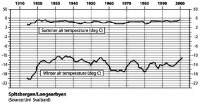
It should not be impossible, as the present arctic warming since 1980 is not the only one. There was another warming period for the region north of 62o North since 1920 until 1945, for which the high-latitude temperature increase was stronger in the late 1930s early 1940s than in recent decades (Polyakov, 2002). The first Arctic warming started 90 years ago, from about 1920 to 1940. In winter 1918-19 the air temperatures exploded at the remote archipelagos Spitsbergen, which the Norwegian call: Svalbard. In 1930 the Norwegian scientist. B. J. Birkeland regarded the rise as maybe the biggest ever observed in one place. Birkeland could presumably repeat the claim today with justification. But would he or his colleagues come up with the exclamation the Arctic is screaming today? Definitely not, although he and his colleagues might wish to scream: How could it be that you know so little about “our arctic warming” to understand “your arctic warming”.
One may only recall a report by the New York Times in 1932 to realize what it could mean when the substance of claims are not clear: “Next great deluge forecast by scientists - Melting polar ice caps to raise the level of the seas and flood the continents”. Is that very different from current claims? At least, C.E.P. Brooks (1938) had that to say with regard to this warming period: “There have been great climatic oscillations before this, even since the last Ice Age, about the causes of which we are quite ignorant”. It seems little has changed when now confronted with the mere allegation, that the warming the NYT and Brooks are talking about has been due to natural variability, even without explaining which part of nature did something, and which did not.

See larger here.
The following investigation will show that the 1st Arctic warming was not understood in the 1930s, and that little has changed to better at the end of the first decade of the 21st century, about seven decades later. What is needed is a better understanding of what had happened almost a century ago in the high northern hemisphere, and this work does not agree with NASA expert Waleed Abdalati notion: “The first step in understanding why things happen is observing what is happening”. See how ice edge has varied in other years below (enlarged here).

See the full book, a fascinating read, downloadable here.
Nov 11, 2009
New geologic evidence of past periods of oscillating, abrupt warming, and cooling
By Dr. Don Easterbrook
Two hundred years ago, Charles Lyell coined the phrase “The present is the key to the past.” In today’s highly contentious issues of global climate change, we might well add “The past is the key to the future”, i.e., to forecast future geologic events, we must understand past climate changes. This paper documents past global climate changes in the geologic and historic past.
Recent laser imaging of the Earth’s surface provides new evidence for abrupt, fluctuating, warm and cool climatic episodes that could not have been caused by changes in atmospheric CO2. In a paper presented at the national meeting of the Geological Society of America in Portland, OR, Professor Don J. Easterbrook, Professor of Geology at Western Washington University, presented new data from airborne laser imagery showing well-defined, previously unknown, multiple moraines deposited by glaciers 11,700 to 10,250 years ago. At least 9 significant, abrupt periods of warming that resulted in retreat of the Cordilleran Ice Sheet are documented by moraines from successive glacial retreats in the Fraser Lowland of NW Washington l(Fig. 1). In addition, smaller multiple glacier recessions are found within the more prominent episodes of glacier retreat. As indicated by the amount of glacier recession between each of the successive moraines, the warming events were of greater magnitude than those observed in recent centuries.
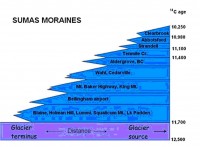
Figure 1. Successive terminal moraines from short-term glacier recessions caused by climatic warming between 11,700 and 10,250 years ago.
Isotope data from Greenland ice cores and show a consistent pattern of fluctuating warm and cool periods over the past 500 years (Fig. 2). The average period of warming/cooling oscillations over the past 500 years is 27 years, remarkably similar to the period of alternation between warm and cool Pacific Decadal Oscillation.

Figure 2. Paleotemperatures derived from oxygen isotope measurements of the GISP2 Greenland ice core. Red peaks are times of warming and blue are times of cooling. The average time period for each climatic oscillation is 27 years.
During the past century, two episodes of global warming and two of global cooling have occurred (Fig. 3), all of which can be tied to glacial oscillations, oceanic temperature changes, atmospheric temperature changes, and solar variation.
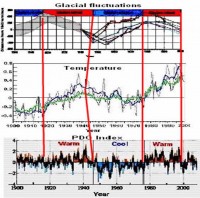
Figure 3. Coincidence of Pacific Decadal Oscillation (PDO), global temperature, and glacier fluctuations in the North Cascades. Glaciers advanced during the 1880-1915 cool period when the PDO was cool, then when the PDO switched to its warm mode, global temperatures warmed, and glaciers retreated from ~1915-1945. The PDO changed from warm to cool ~1945-1977, global temperatures cooled and glaciers advanced once again. In 1977, the PDO switched from cool to warm mode, global temperatures warmed, and glaciers retreated. In 1999, the PDO changed back to its cool mode and global cooling began.
What we can learn from this geologic climate changes is that the past is indeed the key to the future. In 1999, the year after the warmest year of recent times, I projected the climate pattern from the past century and past 500 years into the future and predicted that we would be due for 25-30 years of global cooling beginning about 2000. The PDO changed from its warm to cool mode in 1999 and since then we have had global cooling, quite moderate to flat (interrupted by two warm El Ninos) and intensifying since 2007.
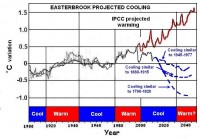
Figure 4. Projection of climate changes of the last 4century and past 500 years into the future. The black curve is temperature variation from 1900 to 2009; the red line is the IPCC projected warming from the IPCC website in 2000; the blue curves are several possible projections of climate change to 2040+ based on past global cooling periods (1945-1977; 1880 to 1915; and 1790 to 1820). The lack of sun spots during the past solar cycle has surpassed all records since the Dalton Minimum and some solar physicists have suggested we may be headed for a Dalton or Maunder type mimimum with severe cooling. See more in PDF here.
Nov 10, 2009
Airborne Fraction of Human CO2 Emissions Constant over Time
World Climate Report
A couple of months back, there was a discussion taking place over at Joe Romm’s ClimateProgress blog concerning a report that the earth’s ability to take-up atmospheric carbon dioxide was declining. A declining CO2 sink, of course, meant that things climatological were going to be even worse than expected, because a growing proportion of anthropogenic CO2 emissions were going to remain in the atmosphere, thus pushing the rise of CO2 concentrations and the degree of climate change higher.
At the time, an alert reader pointed out to Joe Romm that there was in fact, no indication from data and observations that a larger percentage of human CO2 emissions were ending up in the atmosphere. In fact, the data showed that the fraction of CO2 emitted into the atmospheric by human activities has remained constant for the past 40 years.
This fact runs directly counter to the idea that the earth’s natural CO2 sinks are weakening - instead it indicates that natural sinks have been expanding as anthropogenic CO2 emissions have increased. After all, in order to keep the airborne fraction of CO2 emissions constant over time, increasing anthropogenic CO2 emissions must be countered by an increasing CO2 sink.
Joe Romm was a bit dismissive (to say the least) of this line of argument. Here was one such exchange (Comment 13 of this thread):
Comment 13. Chip Knappenberger says:
Mr. Romm,
I am not sure how you justify this statement:"At the same time that CO2 emissions are soaring, CO2 sinks are saturating.” Take your numbers for the rate of CO2 increase each year and divide them by the numbers for the annual global CO2 emissions each year (available from the Carbon Dioxide Information Analysis Center here) and see what you get. Hint: the ppm/emissions ratio shows no trend at all which means that there is no decline in the CO2 sink - otherwise, this ratio would be increasing.
Chip Knappenberger
[JR: It is Dr. Romm, Chip, and, hint, it is what the scientific literature says. Try reading it, some time. Start with the Global Carbon Project.]
Just in case JR (Dr. Romm) really is interested in what the latest scientific literature on the topic says, there is a new paper in the journal Geophysical Research Letters that directly examines this issue. The paper is by Wolfgang Knorr a senior researcher in the Department of Earth Sciences at the U.K.’s University of Bristol, and is aptly titled with the question “Is the airborne fraction of anthropogenic CO2 emissions increasing?” (see Science Daily coverage here).
Dr. Knorr carefully analyzed the record of anthropogenic CO2 emissions, atmospheric CO2 concentrations, and anthropogenic land-use changes for the past 150 years. Keeping in mind the various sources of potential errors inherent in these data, he developed several different possible solutions to fitting a trend to the airborne fraction of anthropogenic carbon dioxide emissions. In all cases, he found no significant trend (at the 95% significance level) in airborne fraction since 1850. (Note: It is not that the total atmospheric burden of CO2 has not been increasing over time, but that of the total CO2 released into the atmosphere each year by human activities, about 45% remains in the atmosphere while the other 55% is taken up by various natural processes - and these percentages have not changed during the past 150 years)
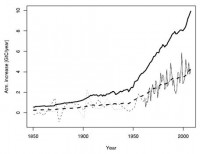
Figure 1. The annual increase in atmospheric CO2 (as determined from ice cores, thin dotted lines, and direct measurements, thin black line) has remained constantly proportional to the annual amount of CO2 released by human activities (thick black line). The proportion is about 46% (thick dotted line). (Figure source: Knorr, 2009)
The Abstract of the paper directly addresses Romm’s concerns, but, unfortunately, Knorr finds no support for Romm’s take on the issue: “Several recent studies have highlighted the possibility that the oceans and terrestrial ecosystems have started loosing part of their ability to sequester a large proportion of the anthropogenic CO2 emissions. This is an important claim, because so far only about 40% of those emissions have stayed in the atmosphere, which has prevented additional climate change. This study re-examines the available atmospheric CO2 and emissions data including their uncertainties. It is shown that with those uncertainties, the trend in the airborne fraction since 1850 has been 0.7 plus or minus 1.4% per decade, i.e. close to and not significantly different from zero. The analysis further shows that the statistical model of a constant airborne fraction agrees best with the available data if emissions from land use change are scaled down to 82% or less of their original estimates. Despite the predictions of coupled climate-carbon cycle models, no trend in the airborne fraction can be found.”
The University of Bristol press release is even more explicit: “New data show that the balance between the airborne and the absorbed fraction of carbon dioxide has stayed approximately constant since 1850, despite emissions of carbon dioxide having risen from about 2 billion tons a year in 1850 to 35 billion tons a year now.”
This suggests that terrestrial ecosystems and the oceans have a much greater capacity to absorb CO2 than had been previously expected.
The results run contrary to a significant body of recent research which expects that the capacity of terrestrial ecosystems and the oceans to absorb CO2 should start to diminish as CO2 emissions increase, letting greenhouse gas levels skyrocket. Dr Wolfgang Knorr at the University of Bristol found that in fact the trend in the airborne fraction since 1850 has only been 0.7 plus or minus 1.4% per decade, which is essentially zero.
Further, Knorr noted that we still have a good bit of work to do to completely understand why this is the case, especially if we want to be able to predict the future course of atmospheric CO2 concentrations (a necessity if we want to predict future climate change). Knorr concludes: Given the importance of the [the anthropogenic CO2 airborne fraction] for the degree of future climate change, the question is how to best predict its future course. One pre-requisite is that we gain a thorough understand of why it has stayed approximately constant in the past, another that we improve our ability to detect if and when it changes. The most urgent need seems to exist for more accurate estimates of land use emissions. Another possible approach is to add more data through the combination of many detailed regional studies such as the ones by Schuster and Watson (2007) and Le Quere et al. (2007), or using process based models combined with data assimilation approaches (Rayner et al., 2005). If process models are used, however, they need to be carefully constructed in order to answer the question of why the AF has remained constant and not shown more pronounced decadal-scale fluctuations or a stronger secular trend.
In other words, like we have repeated over and over, if the models can’t replicate the past (for the right reasons), they can’t be relied on for producing accurate future projections. And as things now stand, the earth is responding to anthropogenic CO2 emissions in a different (and perhaps better) manner than we thought that it would. Despite what Joe Romm would have you believe. See more here.
Reference: Knorr, W., 2009. Is the airborne fraction of anthropogenic CO2 emissions increasing? Geophysical Research Letters, 36, L21710, doi:10.1029/2009GL040613.
Nov 09, 2009
The Real Climate Engine
By Erl Happ
What follows is a general theory of natural climate variation supported by observation of the changing temperature of the atmosphere and the sea between 1948 and September 2009. This work suggests that strong warming after 1978 is an entirely natural phenomenon.
“Mad dogs and Englishmen go out in the midday sun. The sun is much too sultry and one must avoid its ultry violet rays”. Noel Coward 1932.
Perhaps Noel Coward’s observation is particularly pertinent in the southern hemisphere where there is less ozone to absorb UVB. During the warming mode, protective ice crystals evaporate, allowing the surface to warm. Most of the warming activity post 1978 has been in the southern hemisphere in late winter and spring. This warming activity is plainly driven by shifts in atmospheric pressure affecting vortex activity. There are two climate modes:
The Warming Mode:
There is a shift of the atmosphere from the poles towards mid and low latitudes under electromagnetic forcing of ionized air.
Weakening of the polar vortexes curtails the flow of ionized nitrogen into the upper stratosphere allowing the survival of oxygen ions and increased ozone formation.
Intermixing of ozone into the upper troposphere raises temperature in the ice cloud zone. Ice crystals evaporate.
More solar radiation reaches the surface which warms.
In the southern hemisphere 200hpa temperature rises much more than in the northern hemisphere exhibiting strong equinoctial maxima.
Peak anomalies in stratospheric temperature occur in September-October rather than March.
A southern spring deficit in ice cloud density promotes warming across all southern latitudes which promotes the El Nino pattern of sea surface temperature at the equator.
The Cooling Mode
Surface atmospheric pressure increases at the poles as the electromagnetic force in the ionosphere/thermosphere relaxes. This happens at solar minimum as the quantum of ionizing radiation falls to its lowest levels. It also tends to happen at solar maximum as the suns magnetic polarity reverses and magnetic fields emanating from the sun tend to be self cancelling. The manifestation in the Pacific Ocean is La Nina cooling.
Strengthening of the polar vortexes introduces ionized nitrogen into the stratosphere reducing the population of oxygen ions and ozone. A loss of ozone in the ice cloud zone reduces temperature enhancing the formation of reflective ice crystals.
Less solar radiation reaches the surface which cools.
A generally low ozone level in the stratosphere results in high amplitude change in stratospheric temperature during the ENSO cycle. This is expressed in high amplitude variation in 20hpa temperature at the equator. At the surface the swing from El Nino warming to La Nina cooling is more violent and extreme.
Change is more extreme in the southern hemisphere where the polar vortex is generally cooler especially at the highest altitudes. In the cool mode stratospheric temperature exhibits a March maximum probably in line with enhancement of orbital rather than geomagnetic influences on stratospheric temperature. The earth is closest to the sun in January.
A cooler stratosphere and upper troposphere in southern spring promotes ice cloud formation reducing the flux of solar radiation to the surface establishing a La Nina dominant regime in the Pacific Ocean.
The pattern of change from the cool to the warm mode and back again is well expressed in figure 22 showing the pattern of change of the (Darwin-Tahiti) Southern Oscillation Index when compartmentalized according to solar cycle time intervals. A fall in this index represents warming. A dramatic fall in the index occurred about 1978. With the end of solar cycle 23 the globe is emerging from the strongest period of warming in the period of the instrumental record. The Southern Oscillation Index, based on barometric pressure, is not affected by the distortions present in the temperature record.
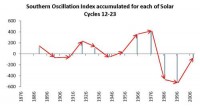
The smoking gun for natural climate variation is an increase in the temperature of the southern stratosphere and troposphere increasing with latitude all the way to the southern pole with a marked variation in southern hemisphere temperature in winter/spring between cool and warm episodes. This determines the strength of El Nino warming events across the tropics.
The smoking gun for greenhouse effects should be a generalized warming at all latitudes without any marked seasonal bias. If there were to be a seasonal bias it should be present as an increase in temperature above the norm when outgoing long wave radiation is maximal in the summer season. There should be no great difference between the hemispheres. That is far from what is actually observed. The evidence suggests that natural variation rather than anthropogenic influences drives climate change.
Conclusion:
Between 1948 and 1976 the tropics and the globe as a whole was fairly stable in temperature with obvious cooling discernable in the decade prior to 1976. From 1977 through to 2000 the tropics and the globe warmed. By comparing data from the earlier period with that for the later period one can discern change in the atmosphere that resulted in more solar radiation reaching the surface of the earth causing it to warm.
Atmospheric conditions in the near earth environment are strongly influenced by the sun. The observed warming of the last decades of the twentieth century can be attributed to natural influences. There is no evidence of any warming signature due to the increased presence of so called ‘greenhouses gases’. It is suggested that the greenhouse hypothesis takes little cognizance of the manner in which the atmosphere actually functions. The atmosphere cools the planet but a change in its temperature causes a change in ice crystal density and the quantum of radiation reaching the surface.
Climatic models suggest that any greenhouse effect should be strongest in the tropical upper troposphere where water vapor is in higher concentration. In point of fact warming of the upper troposphere at the equator is less likely as the globe warms because the quantum of outgoing radiation diminishes as convection and de-compressive cooling is enhanced. It is in the subtropics that outgoing long wave radiation increases and in particular in the high pressure cells where the air is descending and warming and the sky tends to be cloud-free both in terms of liquid and ice crystal density. A water vapor feedback mechanism would require an increase in specific humidity levels in these high pressure areas. The reverse is observed. If a greenhouse effect were present it would be unamplified and tiny. Any warming tendency in these areas is more likely to be due to a loss of ice cloud density than a greenhouse effect.
If the Earth enters a period of cooling, as it has since 1998, it suggests that the natural factor is pre-eminent. If there is a strong relationship between ice cloud density and surface temperature it confirms the point that moisture in the upper troposphere cools rather than warms the planet and the basis of the greenhouse feedback mechanism is negated. Without a water vapor amplifier a change in so called ‘greenhouse gas’ levels can have little or no effect upon surface temperature.
If we can rid ourselves of the foolish mantra that surface temperature is governed by so called greenhouse gas, much unnecessary pain can be avoided. We are threatened by zealous governments keen to interfere in markets, raise taxation and redistribute incomes. The absurd notion that carbon is a pollutant is daily promoted. ‘Will of the wisp’ schemes to generate renewable energy burden the public purse. Nothing is to be gained by these stratagems. Innovation has its own rewards and investment in all forms of innovation is already well enough subsidized and feverishly exploited. Man needs no urging to innovate and will do so quite happily in the absence of artificially inflated monetary incentives. The introduction of market distorting incentives and disincentives destroys rather than creates wealth. This is the tool of the central planner, the social activist, the miscreant.
Distraction and absurdity are our unhappy lot, parading as morality and virtue. Snake oil salesmen multiply by the minute. These are unfortunate times. There are none so blind as those who will not see. The authority of ‘Science’ and the United Nations organization has been subverted to the activists cause. This is a sorry time for mankind. It is a time when belief is substituted for science and the two are irretrievably tangled and confused. Read this amazing full analysis here.
|











